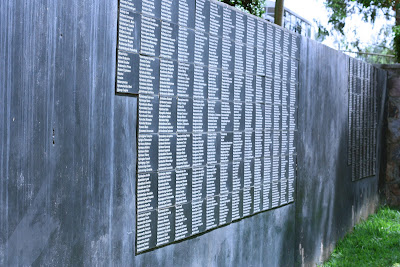“The truth is not believable to someone who has not lived it in his muscles.”
Years ago, I had my first exposure to the Rwandan Genocide when my book club at the time read Left to Tell by Immaculee Ilibagiza. I was absolutely horrified. What bothered me the most, besides the senseless murders of so many people, was the fact that I had no idea it had taken place. Since that time I have read many other books on the subject and have become educated about that fateful 100 days in the Spring of 1994.
I never in a million years thought I would be standing on Rwandan soil, touring the Genocide Memorial in the capital city of Kigali. I was deeply moved. It's hard to believe this country is only 19 years removed from such a horrific experience.
The focus of the country at this time is unification. People are striving to be "one." It is not lawful to discuss ethnic identities such as Hutu or Tutsi, and I sincerely hope that this effort is rewarded with the long term peace the people desire.
The Memorial site is also a mass grave to hundreds of thousands. The large cement slabs to the right are all mass graves. The slate wall on the left is a Wall of Names. Here, my group walks between the two.
The Wall of Names is a work in progress. I am not sure if it is lack of knowledge, organization, or funding that is causing this part to be added so slowly. When the project is complete, this entire extremely long wall will be totally full of names.
There are several outdoor garden areas, each with a different theme to help remember the causes and effects of the Genocide and to caution against that kind of act in the future.
I did not take photos inside the Memorial, but I want to recreate a few of the rooms with words now. After following a path that led me through a timeline of events, I stepped into a dark circular room. There were seats in the middle. I was alone. In sections along the wall, were metal racks filled with simple photographs clipped on with small metal clips. Each display was lit by a floodlight from above. The photos were casual snapshots of families, siblings, babies, grandfathers...the kind that fill our photo albums. There were thousands and thousands. Every person in those photos was killed in the Genocide.
I entered another dark circular room. Four giant display cases sat against the walls. In the first case there were dozens of skulls. The skulls were all different sizes, many bearing visible trauma and broken places where I can imagine a machete or club smashed. In the next case there were hundreds of leg bones. They were all the same type of bone- the fibula or tibia I don't know- but hundreds lay on top of each other. They were all sizes, from all ages of person. The next case held more skulls, the last case more leg bones. They alternated that way and all I could do was stand and look in shock. These were real bones. These are actual people who were brutally killed.
The last room was the Children's Room. There were large poster-sized photographs of various children and under each photo there was a bio. It stated the name, age, favorite food, favorite activity, and a few other facts followed by the method of death. As I wound my way along the path I read of a 10 year old that loved soccer who was tortured to death. I saw an 8 month old baby whose favorite food was mother's milk who was killed by machete in his mother's arms. I looked at photos of 4 year olds and 6 year olds who loved playing with dolls who died by being shot in the head. Other children were burned alive. Each story was a chilling reminder of the atrocity of Genocide that spares not even the youngest and most innocent.
It's hard for me to imagine hatred and death on that scale. Friends and neighbors turned against each other. The large, beautiful Lake Kivu that I gazed upon from my hotel balcony was at one point crowded with bodies and blood. Churches around the country were filled with hundreds even thousands of corpses as those that had sought sanctuary were mercilessly struck down or burned. The Rwanda of today lives within the giant shadow of this savage event. It is miraculous that they have been able to rise from the ashes and destruction as well as they have.
Every year, there is a time of remembering and mourning. A flame is lit for 100 days to mark the time between April and July when so many lost their lives. May Rwanda continue to rebuild in unity and in peace.







1 comment:
Ah, thank you for posting about this and sharing your photos. So interesting. I think memorials are so important for a community/nation because they speak to the horror instead of allowing it to be silent. They also speak for the dead, in a way. Powerful and sobering.
Post a Comment